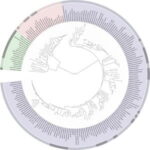‘Yew know, yew always thank, Gosh, we don’t have accents, but I guesss we dew…’ Carol said. ‘…We weynt to Flooreda one tyme, an’ we wer in an elevator, tawkin. An’ someone sayd, [Yew must be from Texas!] An’ we said, [How kin yew tail?]” (qtd in Colloff 46) Of course, natives do not hear their own accents, so spats over the correct pronunciation for p-e-n, short “e” sound pen or a short “I” sound pin, manifest daily between native and non-native Texans. Meanwhile, frequent debates on the use of “ya’ll” as a valid contraction occur between natives of the north and south. Professor Bailey, linguistics researcher at the University of Texas in San Antonio, describes the Texas accent as ‘A Southern accent with a twist’ (qtd Colloff 2).
But, whut rilly make Teksuns tawk funnay? To find the answer to this question many linguists across the United States have turned to dialectical research, and as a result linguists and civilians have divided the state of Texas into dialectical regions. However, no two research findings outline the same divisions. Regions range from two to three divisions to hundreds of divisions. There is a west Texas twang, a south Texas Tex-Mex, and a coastal drawl” (Strawbridge 1). On the other extreme, the Telsur Project, a University of Pennsylvania linguistics project, divides Texas into too many dialectical regions; even those vaguely familiar with the subject would have trouble deciphering the hundreds of regions and their characteristics. An obvious problem exists when people try to attach specific dialects to a state. Because of uncontrollable and inconsistent variables, current dialects continually morph to create new dialects.
Even though historically Texas has been divided into regions of dialect, no number of regional divisions can stand absolute because of three factors historical and current immigration/migration influences, social influences, and urban and rural influences.
Linguists and dialectologists have tried to divide Texas dialects in several ways. The University of Wisconsin shows that Texas falls in only two regions of some United States regional dialect maps – a large portion of the transitional zone and a small portion of the western zone (Jolyne, Alina, and Kenny Olivia). Another University, the University of Pennsylvania, called upon its Linguistics Laboratory to create the Telsur project in an attempt to divide the United States into dialectical regions. The project’s team, also creators of the Atlas of North American English, divides Texas into hundreds of dialects, defining each dialect by a specific consonant or vowel sound (Telsur Project). Texas Christian University (TCU) offers yet another regional option with three divisions including a West Texas twang, a South Texas Tex-Mex, and a Coastal Drawl (Strawbridge). A forth option divides the state into twelve regions: the Mountain and Basin, Llano Estacado, Edwards Plateau, Cross Timbers, Llano Basin, South Texas Plain, Grand Prairie, Blackland Prairie, Post Oak Bell, Pine Woods, and Gulf Coast Plain regions. (Walsh and Monte 42). Even Texans themselves hold opposing views on the types of dialects and to which area the dialects belong. One research librarian at San Jacinto College in Pasadena, Texas, believes “Texas has five regional dialects that go along with its five major regions, making Northern, Southern, Eastern, Western, and Central divisions” (Propes). Joyce Hopkins disagrees with her co-worker. “No. Texas divides into Cajun, Tex-Mex, Redneck (West and deep East Texas), with groupings of German, Check Slovakian, and Polish influence near San Antonio” (Hopkins).
No matter how many years of research linguists and dialectologists put into setting regions, inconsistent variables will continue to cause some dialects to disappear, some to surface, and others to merge. Dr. Guy Bailey is one of two leading researchers on a National Geographic project that will eventually produce the most extensive findings ever on Texas dialects. He says, “The real differences
As time progresses, other factors appear and add to dialectical mutations. Society plays a major role in producing dialects for many reasons which include, dialectical stigmas and the increasing number of intermarriages. Furthermore, large cities such as Houston and Dallas continue to invade rural areas. The merging of city speech and rural speech, a relatively fresh theory, may produce a new language altogether – a more Universal American versus Texas speech (Blumethal 1).
Even though historically Texas has been divided into regions of dialect, no number of regional divisions can stand absolute because of three factors: historical and current immigration/migration influences, social influences, and urban and rural influences.
Since early settlers introduced their foreign dialects to Texas, for people to understand any changes in dialects they must understand the immigration and migration patterns of settlers. “Settlement history is of some significance from the standpoint of linguistic geography, for it partially explains the existence of certain disconformities between Texas dialects and those of contiguous areas” (Walsh and Monte 40).
One historical geographer found three lines of original Anglo-American migration. The northern line begins in Pennsylvania, western Maryland, and Virginia, moves over Kentucky and Ohio into southern Indiana and Illinois, and finally passes though Missouri and Arkansas. The middle line comes from Virginia and the Carolinas and moves through Tennessee and Arkansas, with the southern line following a similar path from the Carolinas to Alabama, Mississippi, and Louisiana (Meining 43). The English language arrived in Texas primarily via the old South; Anglo-American and Afro-American settlers arrived in the eastern and southeastern portions of the state; and immigrants from the upper South and the Old Northwest settled in northern Texas (Walsh and Monte 47). When immigrants from several sections of the United States settled in one area, dialectical features began to transform and merge.
When other American dialects merged with Texas dialects they mutated, so obviously other countries caused even more variations in Texas dialects. Immigration’s largest influence on Texas dialects comes from Mexico, partially because of their close proximity to one another but also because of a racial mixture between Mexicans and Texans after the Spanish conquest in the 1520s. The result of the conquest – Mexican Americans or Tejanos. Mexicans claimed Texas after 1710 and began to colonize immediately. Spanish males and Indian Females began to mix and formed the Mestizo race which grew so large that it almost equaled the Anglo population by 1821 (“Mexican Americans”). Spanish language began to merge with English to form a unique dialect which mixes traditional English grammar styles with traditional Mexican styles, causing many Mexican Americans to use prepositions improperly.
Many overseas countries experienced bad socioeconomic conditions in the nineteenth and early twentieth centuries, while Texas overflowed with unpopulated opportunity. Consequently many immigrants fled to Texas. In 1930 the first Germans settled Texas, and in the 1950s Germans made up five percent of the total population in Texas. Then in 1990, according to the US census, 17 percent of Texans claimed German ancestry. Germans found the farming and government in Texas much more pleasing than those of their home country. “Texas was an earthly paradise” (“Germans”). Soon, Germans became the largest European ethnic group to settle in Texas. Around the same time Germans settled the state, the first Czechs fled to Texas in search of the opportunities that welcomed immigrants. However, Czechs did not fully established themselves until the Civil war, but by 1910 the number of Czechs in Texas had almost doubled since 1900 (“Czechs”). Polish immigrants also began settling Texas to flea their own socioeconomic problems in search of welcoming work conditions. Poles began immigrating around 1830 just as the Germans and the first Czechs. The first Polish wave of immigration began in 1854; however, the streaming flow would slow down to a trickle, along with other major immigration movements, with the start of WWI (“Poles”). Linguistic change becomes hard to resist when so many languages are spoken in a relatively small area.
Two populations merged here
Today immigrants, especially from Mexico, continue to relocate to Texas because of its booming economy, and these migrations continue to affect the unique Texas Dialect. Many Americans also seek economic refuge in Texas, just as foreigners do, because of its potential to grow in size and economic status. Texas has become such a mixture of ethnicities that in the 2000 census 31 percent of Texans said their first language was not English. The establishment of the Space Program in Houston, Texas, in September of 1961 brought significant amounts of Asian and Indian immigrants to Houston. As long as immigrants continue to settle in Texas, their languages will merge and traditional Texas dialects will change.
A second influence, a social influence, determines both dialectical change in Texas and dialectical prevalence in Texas as well as in the rest of the United States. “Ultimately, social factors govern the fate of languages, including minority languages” (“Dialects”). According to the Handbook of Texas online several social factors shape Texas dialects. For example, if Mexicans – for whatever reason – show a drastic decline in immigration or cease to care about their language as far as personal identity, then Texas dialect would eventually lose its Mexican attributes. When minorities marry outside of their own race, sometimes children do not learn the minority language and may adopt a slight southern drawl mixed with their minority language. The function of the minority language, its contributions to the community, the social stigmas attached by to the language by society, and the behaviors and laws that result from those stigmas also influence dialects (“Dialects”). Social events such as wars, new social laws, and new social norms can sometimes heed sudden changes in dialects. For example, laws restricted German social teachings and German language teachings in schools during both World Wars because the Texas government saw all Germans as potentially dangerous. Since President George Bush Junior took office in 2000, many Texans have played down their accents because they do not want the “Texas sayings” that Bush’s statements and dialect have made synonymous with Texans. However, use of certain words, such as “ya’ll” instead of “you all” have caused some Texans to take extra pride in their accents because their accent may become a social norm (Colloff 43). Americans, especially under thirty, have taken a real shine to some Texas phrases because they believe phrases like “ya’ll” are the only phrases that get across a specific meaning. “The Texas accent hasn’t been this cool since, well, arguably since James Dean…” (Coloff 43).
Pop culture also has a huge effect on language, and the recent use of southern phrases in some mediums, like music, has become common. As a result, some Texas dialects and phrase have spread like wildfire and have merged with other regional dialects. Because of its unpredictable nature, society can have a huge influence on immigration and urbanization which in turn affect the use of other dialects and languages. “The most important social factors are age, nativity, and rurality” (Bailey).
Social conflict also causes some people to play down their accents in certain situations. If a native Texan has to deal with a lot of non-native speakers, sometimes the native will try to lose his accent to prevent language barriers from manifesting. Rodney Eatman, professor at the University of Pittsburgh, sees the occurrence all the time as young aspiring actors, not unlike himself at one point, lose their accents “to wipe the slate clean
Recently, a fairly new theory has been milling around the state of Texas, causing controversy among linguists and Texans with its claims that Texas cities may be losing their unique dialects. Pop culture influences like Surf and Valley girl dialects, hailing from the West, and hip-hop influences from all over continue to grow rapidly in major Texas cities like Houston, Dallas, San Antonio, and Austin. Linguist Dr. Guy Bailey describes the phenomenon as the urban-rural split. “The traditional phonology remains strong outside the large metro areas. The real split is between the large metros (Dallas, Fort Worth, Houston, San Antonio) versus everything else. Elsewhere, there isn’t much of a split” (Bailey). New neighborhoods see less and less native influence as industry and business in Texas prosper and attract people from all over the United States and the World. In the last fifteen years massive amounts of immigrants have made it a point to settle in Texas cities so they can take advantage of the state’s potential for economic growth and physical growth into surrounding, unpopulated areas. Even native Texans have begun to notice the change in urban accents. From San Antonio to just west of Houston the huge Spanish influence has just about completely replaced traditional Texan dialect (Wallace 2). Although rural areas may keep more traditional accents because society influences them less, as Americans become more mobile most cities, if not all cities, will develop relatively neutral accents.
Some major universities, like Texas Tech, are notorious for their twangy dialect. As a result, some communications departments in major Texas universities have started programs to help students get rid of their accents so they can enter the workforce with a ‘clean slate’ (qtd in Wallace 3). Since major cities and neutral accents are associated with intelligence and success and rural Texas accents seem to attach a unintelligent hick, negative country stigma, to its speakers, many students have chosen to wave goodbye to their twangs with ideals of completing the shift from rural to urban. A study by Dr. Tillery and Dr. Bailey at the University of Texas found that certain words and dialectical variations common in most rural areas have started to fade quickly in all major Texas cities. “Most of the traditional lexicon is rapidly disappearing, and in urban areas some traditional phonological features (I.E., the pen/pin merger) are disappearing” (Bailey). Along with the pronunciation of ‘pin’ versus ‘pen’ (pin/pen merger), Texas cities have seen pronunciation of ‘tin cints’ verses ‘ten cents’ disappear as well. Also,
“Urban Texas is abandoning the ‘y’soud after ‘n,’ ‘d’ and ‘t’ exchanging dpthongs for monophthongs. So folks in the cities read a ‘noospaper’ – what their rural counterparts call a ‘nyewspaper.’ They’ll hum a ‘tyewn’ on the range, a ‘toon’ in Houston. The upgliding dipthong, too, is an endangered species in the cities, where a country ‘dawg’ is just a dog” (Blumenthal 1).
The spread of common southern words like “ya’ll” to other cities may also contribute to a more Americanized Texas because since the phrase has become somewhat universal, society does not judge Texans for their speech as much as they did a few years ago when “ya’ll” was indigenous to Texans and the South. Seventy six percent of eighteen to twenty-four year olds outside the south say “ya’lll” which is pretty close to equal with the eighty-three percent of southerners who use the word (Blumenthal 1). Some cities have seen such mixed patterns that talk of an entirely new dialect has begun; however, no conclusive studies have been conducted on a complete and new city/rural merger.
Enumeration : Because of three inconsistent influences – historical and current immigration/migration influences, social influences, and urban and rural influences – Texas can not have absolute dialectical regions.
Some Native Texans may like their twangs and their slurring, and evurwonsinawhahl may want to write to their chilrin bout’ ther speeriences growin’ up, but even though it may sadden some Texans, their children will not share their exact pronunciations. Their children will not watch Will Rodgers and listen to Willie Nelson; they will watch American Idol and listen to Justin Timberlake and their classmates will come from at least several different cities across the United States. Whether the major influence on dialectical mutations is a change in immigration/migration patterns – a change in social patterns or social norms – a change from traditional rural dialect to a more Americanized urban dialect – or a change in all three factors, Texas dialect will change. As old dialects take on new forms, some researchers accept that inconsistent variables shape Texas dialects, and as they shrug they say, hey, ‘this is Texas, and things are just different here’ (qtd in Blumenthal 1). Other linguists may desperately continue to group Texas dialects according to their flattened vowel sounds or their regional phrases like “y’all” and “fixin to”, but no linguist can ever tame the ever-changing Texas dialects no matter how tight dialectical ropes harness their regions.
Even though historically Texas has been divided into regions of dialect, no number of regional divisions can stand absolute because of three factors: historical and current immigration/migration influences, social influences, and urban and rural influences.
Works Cited
Bailey, Guy. “NY Times Article (Texas Dialects).” Email to the author. 4 May 2004.
Blumenthal, Ralph. “Scholars of Twang Track All the ‘Y’Alls’ in Texas.” New York
Times. 28 Nov 2003, late edition east coast: A1.
Colloff, Pamela, and Keyes Christopher. “Drawl or Nothin’.” Texas Monthly
“Czechs.” The Handbook of Texas Online. The Texas State Historical Association.
29 April 2004. 25 April 2004 .
“Dialects.” The Handbook of Texas Online. The Texas State Historical Association.
29 April 2004. 25 April 2004 .
“Germans.” The Handbook of Texas Online. The Texas State Historical Association.
29 April 2004. 25 April 2004 .
Hopkins, Joyce. Personal interview. 3 May 2004.
Jolyne, Alina, and Kenny Olivia. Regional Dialects in the United States.” University of
Wisconsin Milwaukee. 2 September 2003. 24 April 2004 .
Meining, D. W. Imperial Texas. Austin: U of Texas P, 1969.
“Mexican Americans.” The Handbook of Texas Online. The Texas State Historical
Association. 29 April 2004. 19 April 2004 .
“Poles.” The Handbook of Texas Online. The Texas State Historical Association.
29 April 2004. 24 April 2004 .
Propes, Terri Personal interview. 3 May 2004.
Strawbridge, Steffanie. “texas: if you can’t stand the heat, go home!” Above the Din.
Texas Christian University. 9 December 2002. 24 April 2004
.
Telsur Project. University of Pennsylvania. 19 April 2004
.
Texas Quick Facts.” US census Bureau. 30 April 2004. 24 April 2004
.
Wallace, Terry. “Texas twang: Fixin’ to fade?” Star-Telegram.com 24 March 2002.
24 April 2004 < http://www.dfw.com/mld/dfw/news/state/2924939.htm?1c>.
Walsh, Harry, and Victor L. Monte. “A Texas Dialect Feature: Origins and Distribution.”
American Speech 49.1/2 (Spring/Summer 1974): 40-54.





